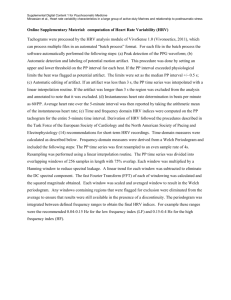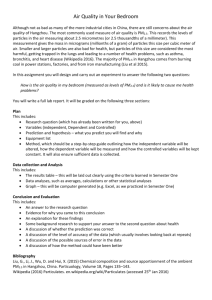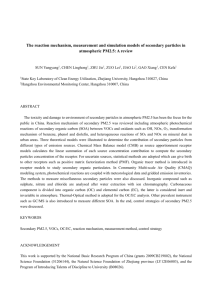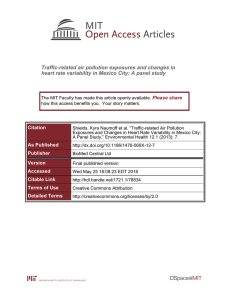Sustainability at DNP
advertisement
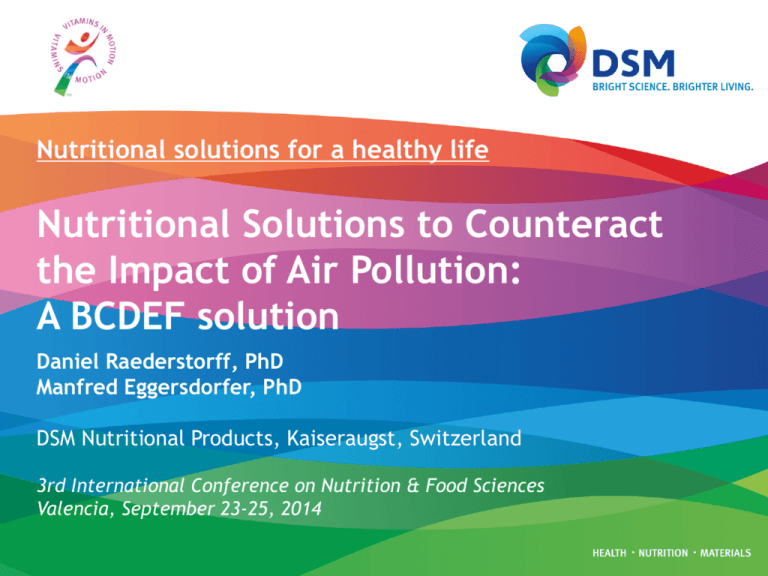
Nutritional solutions for a healthy life Nutritional Solutions to Counteract the Impact of Air Pollution: A BCDEF solution Daniel Raederstorff, PhD Manfred Eggersdorfer, PhD DSM Nutritional Products, Kaiseraugst, Switzerland 3rd International Conference on Nutrition & Food Sciences Valencia, September 23-25, 2014 The 2005 WHO Air quality guidelines (AQGs) Clean air is considered to be a basic requirement of human health and well-being However, air pollution continues to pose a significant threat to health worldwide Composition Particulate matter (PM) Ozone (O3) Nitrogen dioxide (NO2) Sulfur dioxide (SO2) PM2.5 Diameter 2.5 μm PM10 Diameter ≥ 2.5 μm AQGs for PM PM2.5 10 μg/m3 annual mean 25 μg/m3 24-hour mean PM10 20 μg/m3 annual mean 50 μg/m3 24-hour mean Page 1 Air pollution a global problem Global satellite -derived PM2.5 levels averaged over 2001–06 μg/m3 • An overlap with maps of population density suggest that more than 80% of the world's population breathe polluted air that exceeds the WHO recommendation (<10 μg/m3 annual mean). • White space indicates water or locations containing < 50 measurements. http://www.nasa.gov/topics/earth/features/health-sapping.html Page 2 Environ Health Perspect 2010;118:847 http://www.nasa.gov/topics/earth/features/health-sapping.html Which adverse Health Effects have been linked to PM 2.5? • • • • • • • • • • • Premature death Lung cancer Exacerbation of COPD Development of chronic lung disease Decreased lung function Heart attacks Hospital admissions and ER visits for heart and lung disease Pre-term birth, Low birth weight Respiratory symptoms and medication use in people with chronic lung disease and asthma Increased risk of CVD and diabetes Increased risk of cognitive deficits Air pollution delivers smaller babies Study of 3 million infants suggests connection between inhaled particles Page birth 3 and weight (Nature, Feb 6, 2013) Major responses of the body to air pollution by particulate matter (PM) • PM enters respiratory system when we inhale • PM10 is mostly eliminated by cough, sneeze and swallow • PM2.5 travels all the way to alveoli in lung and causes local and systematic harm including: Oxidative stress Inflammation insult Disturb the autonomic nervous system (ANS) Adapted from www.bcairquality.ca/health/air-quality-and-health.html ; http://www.icao.int/environmental-protection/Pages/Contaminants.aspx Page 4 Mechanistic link between PM and CVD Inhalation of Particulate Matter ANS imbalance Adapted from Miller M.R. et al., 2014 Short- and long- term exposure to PM air pollution is associated with an increased risk of CV morbidity and mortality Page 5 Some population groups are more at risk • People with heart / lung disease: Conditions make them vulnerable • Older adults: Greater prevalence of heart / lung disease • Children: More likely to be active Breathe more air Bodies still developing Page 6 Nutrition & Chronic diseases the link with PM • Nutrition is a key factor for the prevention of chronic diseases (CVD, diabetes) • Small dietary changes can lead to a large reduction in the burden of CVD. – Eating less fat and fewer calories – Decrease sugar, salt and saturated fat intake – Increase fiber, fruit and vegetable intake – Adequate intake of micronutrients and PUFA Nutritional epidemiology showed that specific nutrients play a key role in maintaining a healthy body and reducing the risk of chronic disease such as CVD. Page 7 Page WHO, IDF http://www.diabeticdietplan.net/diabetic-diet-plan-1/ 33% 33% 12% 7% 15% Nutrition solution (A BCDEF solution): Page 8 B: Vitamin B’s C: Vitamin C D: Vitamin D E: Vitamin E F: Fish oil Heart rate variability (HRV) • HRV is regulated by the autonomic nervous system (ANS) and is used to assess the integrity of the ANS • HRV measures the fluctuation between heart beats Time-domain indices of HRV: SDNN is the standard deviation of all normal beatto-beat interval (RR intervals) over a period of time. In young adults it is about 40-60 ms. HRV declines with age ms Frequency-domain indices of HRV: Analysis of the fluctuations in the frequency domains Analysis in the High frequency (HF) range reflect exclusively parasympathetic activity Analysis in the Low frequency (LF) range reflect mainly sympathetic activity • http://www.sunscientific.com/What-is-ANS.html A reduction in HRV is positively correlated with increased cardiac morbidity and mortality. HRV parameters are early indicators of body stress and disease. Page 9 Air pollution and HRV among elderly in Mexico city • In Mexico City, 34 nursing home residents underwent heart rate variability analysis every other day for 3 months. • 24-hour average levels of PM2.5 – Indoor PM2.5: 15-67 g/m3 – Outdoor PM2.5: 9-87 g/m3 • Daily 1-hour max. ozone levels: 47-228 ppb Change in HRV for a 10 µg/m3 increase in PM2.5 HRV-HF 0.00 -0.02 -0.04 -0.06 -0.08 All -0.10 Normotensive -0.12 Hypertensive • PM2.5 exposure significantly reduced high frequency component of HRV in elderly. • Hypertensive subjects are more susceptible Page 10 HRV-LF Holguin et al. 2003 Cardiac autonomic changes in elderly supplemented with fish oil • Elderly subjects (n=58) consumed 2 g/d of either fish oil or soy oil for 4 months after a 2 months presupplementation period to establish an HRV baseline for each participant . • Time-domain and frequency-domain analysis of HRV was measured Net change from baseline 0.3 Fish oil 0.2 Control 0.1 0 Total HRV † HF † LF † SDNN † log10 (ms2)/100,000 ‡ log10 (ms2) Fish oil was associated with a significant increase in HRV Page 11 Holguin et al. 2005 ‡ Omgea-3 PUFA presented HRV reductions associated with PM2.5 • Elderly from a nursing home (n=50, >60 y) received 2g/d of either or fish oil or soy oil for 5 months after a 1 months presupplementation. • Indoor mean PM2.5 levels: 18.6 µg/m3 (8 SD). • Parameters: Timeand frequency domain analysis of HRV Fish oil 0% -10% Change in HRV for an increase in 1 SD (8 µg/m3) of PM2.5 HRV-HF SDNN Before After -7% -54% -27% -15% P<0.01 (-27%)-(-0.5%) = -26.5% 0% -15% -4% -18% 46% -54% P<0.01 (-54%)-(-7%) = -47% 0% -15% -46% -30% -16% p=0.10 (-18%)-(-4%) = -14% Fish oil significantly decreased the negative impact of PM2.5 on HRV in elderly Page 12 -60% -15% -24% After -7% -45% -30% -8% Before -30% -20% Control 0% Romieu et al. 2005 -45% -60% p=0.11 (-46%)-(-15%) =-31% Omgea-3 PUFA enhanced antioxidant defense in elderly exposed to PM2.5 % change from baseline • Elderly from a nursing home (n=52, >60 y) received 2g/d of either or fish oil or soy oil for 4 months after a 3 months pre-supplementation. • Indoor mean daily levels of PM2.5 38.7 µg/m3 (14.7 SD). • Parameters: superoxide dismutase (SOD), glutathione (GSH) and lipoperoxidation (LPO). • PM2.5 decreased SOD activity and GSH levels • Fish oil modulated the oxidative stimuli by increasing SOD activity and GSH levels SOD 49.1% 60 40 95% CI: 2.4-81.5 22.6% 95% CI: 0.7-44.0 20 0 Control GSH 70 60 62.0% 55.3% 13 Romieu et al. 2008 95% CI: 43.3-89.0 95% CI: 36.3-85.1 50 40 Control Page Fish Oil Fish Oil Omega-3 PUFA attenuate particulate matter induced cardiac effects • Healthy subjects (n=29, 50-72 y) received 3g/d of either or fish oil or olive oil for 4 weeks before sequential chamber exposure to filtered air or ambient particulate matter (mean mass concentration 278 µg/m3). Effect of PM on frequency domain indices of HRV • Parameters: Time and frequency domain changes in HRV and electrocardiographic repolarization changes measured before, immediately after, and 20 h after exposure. Omega-3 PUFA protect against the deleterious effects of acute exposure to PM Page 14 Tong et al. 2012 Dietary methyl nutrients prevent cardiac autonomic dysfunction induced by PM2.5 Baccarelli et al. 2008 Study design: • Elderly men (n=549) from the Boston area (Normative Aging Study) had HRV measured in either 1 (n=363) or 2 (n=186) visits. • The 48-hours moving average of PM2.5 was used as exposure index. • Genotyping of the C677T MTHFR and C1420 cSHMT were performed. Each 10 µg/m3 increase in PM2.5 concentration • Dietary intake of folate, vitamin B6, B12, and methionine were derived from the food-frequency questionnaire. Results: • MTHFR 677 CT/TT genotypes had lower HRV than subjects with CC genotypes • PM2.5 effects on HRV were stronger in subjects with MTHFR 677 CT/TT and cSHMT 1420 CC genotypes • The reduction in HRV associated with PM2.5 level was abrogated in subjects with higher intakes of B6, B12 and methionine. Page 15 7% reduction in SDNN SDNN (Time-domain indices of HRV) : standard deviation of normal to normal intervals PM 2.5 reduces HRV/SDNN, which is prevented by vitamin B’s Low High 1.9% Vitamin B6 intake 13.1% ≥3.65mg/d n=356 Folate intake -8.8% ≥495.8µg/d n=354 <495.8µg/d n=353 <3.65mg/d n=357 3.0% 1.2% Vitamin B12 intake <11.1µg/d n=356 Page 16 -13.2 ≥11.1µg/d n=356 5.7% Methonine intake 11.9% ≥1.88mg/d n=351 <1.88mg/d n=352 DRI B6: 1.2 mg/d B12: 2.4 µg/d Folate: 400 µg/d Baccarelli et al. 2008 Sources of vitamin D The role of sunshine.... • Main source: Sunlight (UVB 290–315 nm) induces vitamin D production in skin (80 – 90%) ...influenced by various determinants • Sunshine exposure • Latitude > 37 / Season • Ethnicity (skin pigmentation) • Aging • Weather & air pollution • Sunlight exposure • Sunscreen use (>SPF 8) • Obesity • Minor source: Food intake of vitamin D is scarce (10 -20%) (mainly fatty fish) • Alternative source: Fortification and supplements Page 17 ...further factors • Degree of clothing (veiling) • Increase in urbanization • Lifestyle (limited outdoor activity) Air pollution compromise the vitamin D status • Vitamin D status is usually dependent on skin exposure to sun’s UVB radiation • Air pollution decrease UVB light and thereby reduce skin vitamin D synthesis Vitamin D status of healthy women in Iran 30 Total 25(OH)D (ng/ml) Relationships among vitamin D status and sun exposure index in Belgian urban and rural postmenopausal women Study conducted in September; age 20 to 55 years ; values are median (IQ: 25-75) 25 20 15 * 10 5 0 Teheran Ghazvi (more pollluted area) (less polluted area) Hosseinpanah et al. 2010 Vitamin D status of infants and toddlers in Dehli, India Study conducted in March, April; age 9 to 24 months ; values are mean (1SD) Study conducted in June, July; age 51 to 81 years Manicourt et al. 2008 Total 25(OH)D (ng/ml) 35 30 25 20 * 15 10 Agarwal et al. 2002 5 0 High pollution area Mori Gate (n=26) Air pollution increase the risk of vitamin D deficiency Page 18 Low pollution area Gurgaon (n=31) Antioxidant intervention reduced oxidative stress in subject exposed to PM emissions from coal combustion Study design: Subject exposed to airborne contamination were supplemented with Vitamins C 500 mg and E 800 mg for 6 months. A panel of biomarkers of oxidative stress was measured before and after supplementation and compared to a control group Non-enzymatic oxidative stress markers Coal em. AOX supple. TBARS PC: protein carbonyls Norm GSH: glutathione Norm. PT: protein thiols α-tocopherol Enzymatic oxidative stress markers Coal em. AOX supple. SOD: superoxide dismutase CAT: catalase Norm. GPx: glutathione peroxidase Norm. GR: glutathione reductase Norm GST: glutathione Stransferase Norm. Antioxidant supplementation improved both enzymatic and non-enzymatic antioxidant defense systems in subjects exposed to PM Page 19 Summary PM2.5 a major component of air pollution is a health threat PM 2.5 is a global and long-term problem It’s solvable, but neither easy nor quick Nutrition solution: PM2.5 induced damage are reduced by fish oil and some vitamins Omega-3 PUFA improve heart function and attenuated HRV decline induced by PM2.5 exposure. B vitamins prevented the decline of heart rate variability (HRV) induced by PM2.5 exposure. vitamin E and C reduce PM2.5 induced oxidative stress Air pollution has a negative impact on vitamin D status Various combinations of nutrients may prevent the impact of PM on different aspects of health. Page 20
